Yesterday, I received a copy of a paper on the development of the Loch Lomond and Trossachs National Park Authority’s Camping Development Strategy which had been considered by their “Delivery Group” on 22nd November 2018. This post will take a look at what that paper tells us about the adequacy of provision for campers in the National Park alongside what the LLTNPA said about this in their annual report to Scottish Ministers. First, however, some commentary about the continued reluctance of the LLTNPA to act openly and transparently and the consequences of this.
Lack of transparency and Freedom of Information requests
The LLTNPA has had a Delivery Group for a number of years – it oversaw the development of the camping byelaws by staff and has a remit to focus on delivery of other important “projects”. For a long period it operated entirely in secret but, in the last year, under the convenorship of Colin Bayes (now retired from the Board) has become slightly more open. Its membership was decided in public at the December Board meeting (Chair – Martin Earl; Depute Chair – Danny Gibson; Members – Heather Reid, Sarah Drummond, Diane Doherty, Willie Nisbet, Bob Darracott). There was also reference in the December Board Papers to matters considered by the Delivery Group in November:
4.3. The Delivery Group considered updates on the following priority projects:
Callander’s Landscape
Camping Development Strategy
Litter
Car Park Charging
The Delivery Group also received an end of project report and lessons learned report in respect of the Gateway Centre; a priority project that has recently completed.”
All these issues are of public interest, whether to the local communities affected (Callender and Balloch), or to the wider public (litter, camping and car parking). I wrote therefore to James Stuart, Convener of the National Park, on 9th December, the day before the Board Meeting, suggesting that the papers for the Delivery Group should be made public as a matter of course – just as now happens with the Chairs Group (see here). But, failing this, I requested copies under Freedom of Information laws. Rather than respond to my suggestion, James Stuart has decided, without any explanation or justification, to deal with my request under Freedom of Information laws EIR 2019-002 Response Delivery group.
I believe this is indefensible. The Delivery Group clearly has a formal function within the LLTNPA governance structure, just like the Chairs Group whose papers are now public. The Cairngorms National Park Authority has a Finance and Delivery Group and its meeting papers are public. What’s more “last week saw the launch of Scotland’s 2 year open government action plan – part of an international initiative to promote transparency, participation and accountability across all government” (see here). How on earth does James Stuart’s failure to respond to my suggestion that the Delivery Group papers should be made public fit with that?
The LLTNPA is also being hyprocritical about this. In mid-January I received a letter from the LLTNPA saying that they would file rather than respond to correspondence from me unless it was a complaint or information request. They then referred to the number of information requests I have submitted implying this was unreasonable (as they also did in a paper to the Board last June). Yet, a large proportion of the information requests concern information which in any reasonably run public authority should be in the public realm as a matter of course. The papers for the Delivery Group provide a perfect illustration of this. Instead of making papers public as a matter of course, the senior management team would prefer to force people to submit information requests with all the work that creates for frontline staff.
Its time the LLTNPA Board started to address these issues rather than leaving this to the convenor and senior staff. Perhaps the new Delivery Group could take a lead publish its papers?
The Camping Development Strategy
The paper to the Delivery Group on the Camping Development Strategy (see here) contains important information which the LLTNPA failed to include in their Annual Report to Ministers (see here) and provides further insights into the LLTNPA’s incoherent approach towards provision for campers. The LLTNPA was supposed to approve a revised camping development strategy focussed on infrastructure in September but this has now been delayed indefinitely.
The level of provision for campers
Instead of allowing people to choose where they wanted to camp by the lochshores, as happened under Access Rights, the camping byelaws have restricted campers to certain permit areas within the four camping management zones in the National Park. The LLTNPA promised Ministers to deliver:
“300 camping places in the first year of the byelaws operating, with more to be added in subsequent years.”
This is what they have reported to Ministers for 2018:
“306 low cost camping places were ready from the start of March 2018, including spaces for tents on permit areas, pitches at informal campsites and spaces for motorhomes at popular visitor locations off the public highway – see Appendix 2. As with any camping provision, the number of permits spaces available did fluctuate slightly during the season due to factors affecting ground conditions and access, such as flooding following heavy rain, forestry operations or the need for essential maintenance.”
So officially, the LLTNPA claim to have added a grand total of just 6 new places in the second year of the byelaws. If that is not disgraceful enough, the truth is that the LLTNPA have provided far fewer than the number of places they have promised. The Report to Ministers is worded very carefully – it appears the authors did not want to perjure themselves. What 306 places being “ready” on 1st March means is that if on that date you had tried to book a place through the online booking system you would have been given 306 choices. It did not mean that all 306 of those places were campable. For example a number of the permit areas are located on beaches which are often underwater.
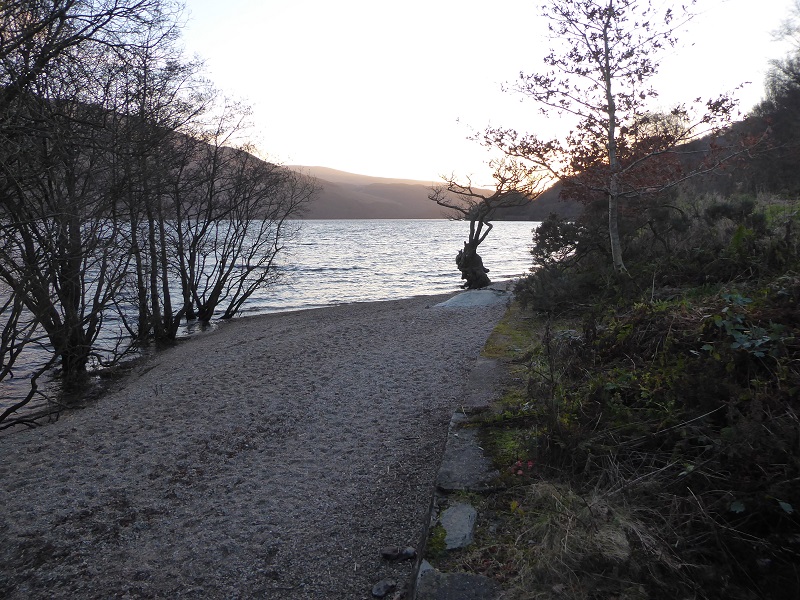
Other permit areas are choked by vegetation or on ground unsuitable for camping:
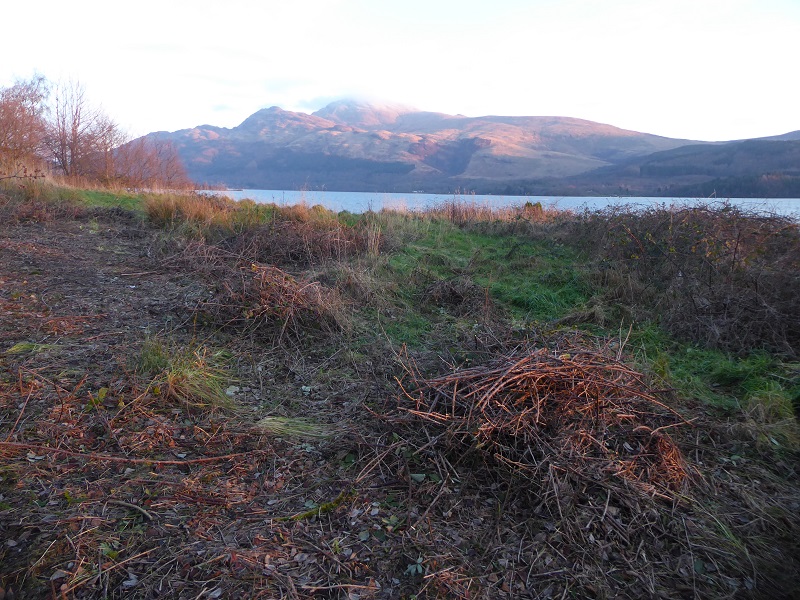
Suie Field for example used to provide a large grassy area for camping but since the byelaws were instigated has become overrun with brambles restricting the area where people can camp.
All of this is tacitly admitted in the Report to the Delivery Group:

The lack of places for campers, however, is made worse because, as the Report to Ministers, said:
“As of the start of the season on 1st March 2018 there were 44 permit areas across the four Camping Management Zones. Of these, 34 were designated for tent camping and 10 were provided for motorhomes”
What this shows is the LLTNPA is still counting campervan provision as part of the 306 places, even though its admitted the byelaws are almost unenforceable against campervans as they have a legal right to stop off along the road throughout the National Park. The consequence is that while campervanners are still basically free to stop where they want, campers are restricted both in numbers and areas.
A reasonable guesstimate is that effectively there are now only c200 half-reasonoble places to camp in the camping management zones in the National Park. This compares to the 850 tents that were recorded in the past at peak times. That is a drastic reduction in camping. It hits anglers and poorer people most.
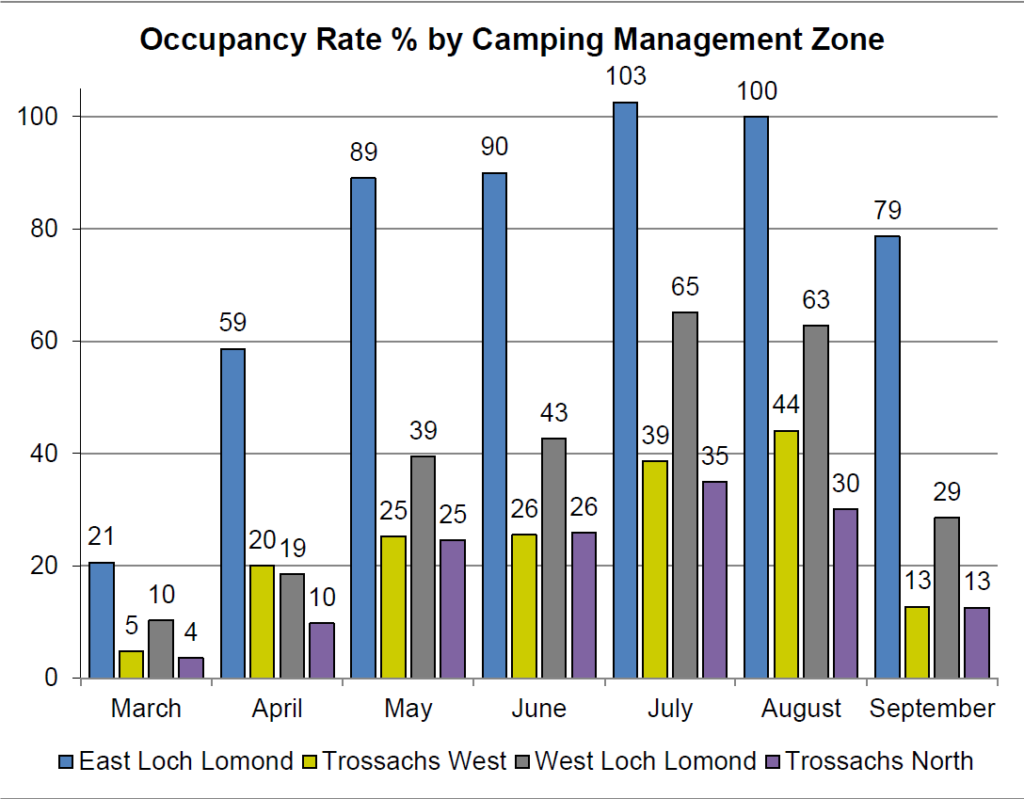
Not a Board Member at the December meeting thought to ask why there is such a variation between occupancy rate between the camping management zones let alone if there was varying occupancy between different permit areas and the reasons for this. Part of the explanation is that a large proportion of the camping permit areas are uncampable. Another is that they are not within the areas where people want to camp. The result is not just that there are far less than 300 places promised, of the 200 or so that exist many are in the wrong place.
The Report to Ministers, however, claims:
Despite the need to take some camping places temporarily off the booking system, analysis of bookings and camping provision shows that availability met demand for camping across the season. While some permit areas and Loch Chon campsite reached 100% occupancy at key weekends in the summer, capacity was available at other locations. A flexible approach to the number of camping places available continues to be required to ensure sustainability, adequate provision and a high
quality experience.
That capacity is completely useless if its in places people don’t want to camp or is not suitable for their chosen activity. What was clear from the discussion at the Board Meeting, however, is that Rangers now spend lots of their time asking campers who have turned up at areas which are “fully booked” to move elsewhere. That’s not much use for people walking the West Highland Way so, as the Park admits, sometimes Rangers use their “discretion” to allow people to camp:
An occupancy level of 103% was reached in July in the East Loch Lomond Camping Management Zone. This is attributed to the limited number of permits that can be sold in a Camping Management Zone, with East Loch Lomond only containing one permit area, (although considerable camping
provision is available at the other more formal campsites in the area). Wherever possible Rangers will assist campers to comply with the byelaws. In some cases such as West Highland Way walkers who find themselves fatigued and too far from a formal campsite, Rangers will give some discretion
in the application of the byelaws, which in a limited number of cases may lead to temporary over-occupancy in permit areas.
So, for the entire month of July OFFICIALLY there was not enough capacity along the West Highland Way. What the Delivery Group makes clear is the LLTNPA has absolutely no plans to address this shortfall as for 2019 new permit places are only proposed for Ardgarten, Loch Achray (the delayed campsite) and Loch Venachar (where two permit areas have now been closed for over a year).
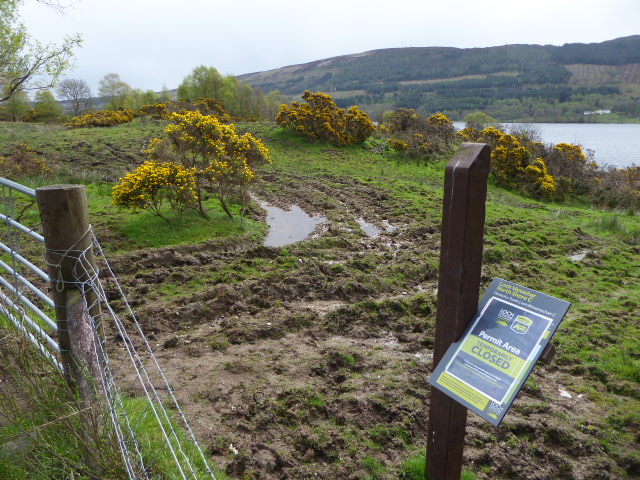
In other words, throughout the four camping management zones only one new permit area is planned for 2019 and none on East Loch Lomond. So much for the West Highland Way offering a world class walking experience. So much too for the National Park putting young people, who make up the majority of backpackers, first.
Instead of a clear vision of the number of places needed the main concern expressed to the Delivery Group Group was the risk that numbers of places could drop below the 300 promised to Ministers:

That I think is another indication that the LLTNPA has not delivered what it promised and is miles away from being able to produce a forward looking assessment of what camping provision is actually needed.
Why is the current level of provision so poor and so little new provision planned?
Three explanations for the lack of camping places are implicit in the Delivery Group report, though never explicitly discussed or addressed.
The first is the difficulty the LLTNPA is having reaching agreement with landowners. Examples include :
In 2017 seasonal toilet and parking provision at south Loch Earn was not possible to progress as no agreement could be reached with the land owner.
And,
“New permit areas have been identified and ……….have involved protracted landowner engagement.”
And,
“In some areas of the Park we have not been able to reach agreements with landowners on solutions to alleviate camping related pressures and these areas will require an alternative approaches”.
The problem here, which Parkswatch has highlighted before, is that by creating camping byelaws, the LLTNPA have handed power over to the landowners. Before there was an incentive to co-operate with the LLTNPA to manage any visitor pressures. Now, with the Park effectively policing all the loch shores, there is no reason to do so. Indeed, while occasional campers in the past had some impacts, permit areas are concentrating campers in a few places. Any landowner providing a half decent permit area is likely to be faced with the very problems of over-use that some claimed the byelaws were supposed to address. It easiest not to co-operate or demand large sums of money for doing so, hence the lack of progress in negotiations. The LLTNPA has made it impossible for its staff to negotiate effectively with landowenrs.
The second reason for lack of new camping places is money, as shown in the Delivery Group report:
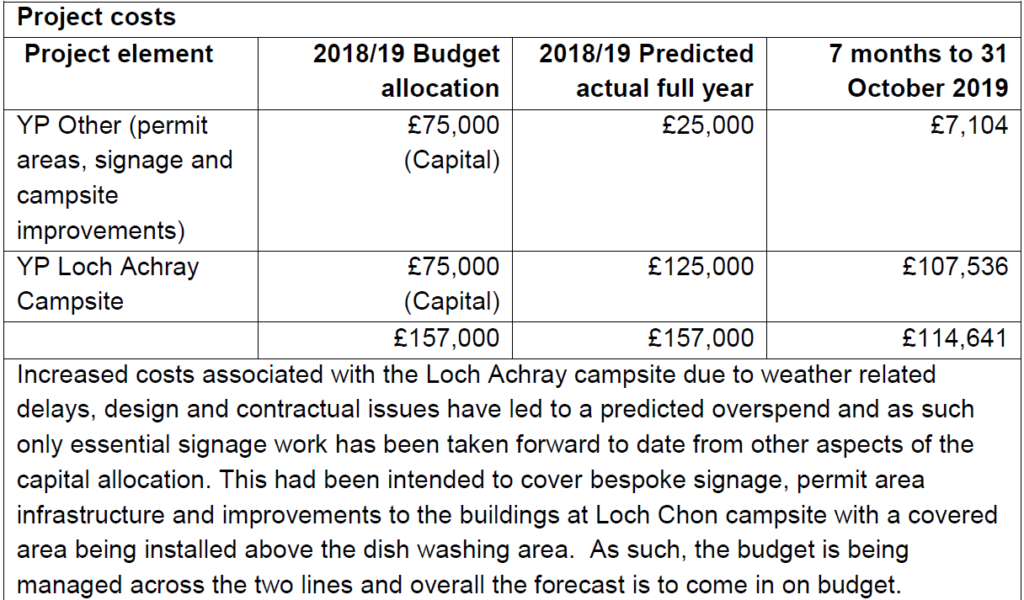
This shows that, having spent so much on the Loch Achray campsite, there was simply not the money to fix the issues at Loch Chon let alone “improve” some of the permit areas which were not fit for purpose.
While the LLTNPA claimed to Ministers that increasing visitor numbers at Loch Chon were a success, what they didn’t say is its far from paying for itself:
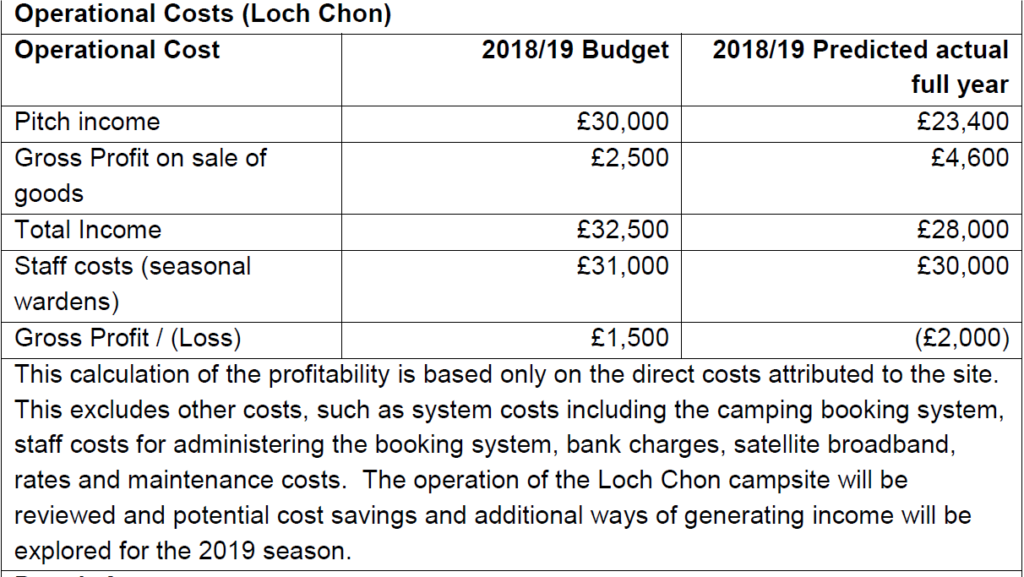
The £2000 loss appears little until you read the blurb below – what is the actual cost and actual loss?
What’s more it appears the Park’s plan is to increase the number of places at Loch Chon, possibly to bring more income:
Improvements to the Loch Chon buildings, new permit areas and bespoke signage is currently being costed
It will be interesting to see if the LLTNPA consults publicly on these proposals and goes back to the Planning Committee for a decision to increase the number of places. In order to win acceptance from the local community for this campsite, the LLTNPA reduced the number of places originally proposed! No mention of that to the new Board Members on the Delivery Group.
While its not unreasonable that the LLTNPA subsidises the cost of operating campsites as part of its recreational remit, the cost of administering the camping byelaws is another matter. The Delivery Group reports records income brought in in 2018 through the permit system:
Neither this nor the cost of enforcing the camping byelaws is included in the report to Scottish Ministers. A cost/benefit analysis of the camping byelaws would soon show they have been a total waste of scarce public resources and that because of all the money that the LLTNPA is devoting to enforcement, they have very little money to improve infrastructure for campers.
The third and more fundamental problem underlying the lack of camping provision is the camping byelaws themselves and the complete lack of clarity from the LLTNPA about their purpose. While the Delivery Group Report contains the usual spin it also makes this extraordinary statement:
The proposed byelaws are essential to enable us to deliver:
1. A permit system to allow informal camping within defined areas of the Management Zones
2. Campsites with low-cost bookable pitches and basic facilities
This is just total rubbish. The permit system was included in the byelaws, which fundamentally attempted to ban camping, in order to allow some camping to continue. In the eyes of some, it appears, the purpose of the byelaws is to enable the bureaucratic nightmare created by the permit system to continue.
The muddle is caused by the LLTNPA having no clear agreed vision (the justification for the byelaws keeps changing) and looking two ways. Some people in the LLTNPA would prefer camping not to take place at all, hence the minimalist approach to camping places, others – including staff on the frontline – would genuinely like to improve camping provision but are constrained from doing so because so much resource is being devoted to policing campers. The result is statements as clear as mud:
Infrastructure: Is still important and key locations for low camping provision remain Loch Earn, Loch Long, Loch Venachar and the west shore of Loch Lomond. Increased parking spaces and waste disposal services for motorhomes will be required to meet demand. The delivery of this infrastructure will not be for the Park Authority alone and working in partnership with existing partners, communities and private enterprise will be essential. Improving essential visitor services that can support both campers and day visitors on the Park Authority estate will be a focus for our investment.
What needs to happen
Pressure needs to be kept on the Park, first to come clean about the number of camping places they have actually provided, second to accept this is totally inadequate and third to engage with stakeholders about the solutions.
What I believe the Delivery Group report shows is that unless the camping byelaws are dropped, we are unlikely ever to see the type of proper camping infrastructure in the National Park that the LLTNPA promised as part of the byelaws and which I believe Scottish Ministers expected. Without the camping byelaws and permit areas, many camping pressures would disperse and there would be the resources to develop infrastructure (mobile toilets, waste collection) in the places which are very popular for a few months over the summer. A full cost benefit analysis of the camping byelaws would support this argument.
Whether or not the new Board are capable of taking a more critical view and changing course remains to be seen.
The LLTNP will never be able to provide adequate facilities for informal camping, unless they use their compulsory purchase powers. Too many private landowners in the Park are able to thwart the Park’s ambitions by years of procrastination, holding the Park to ransom. A better way forward is likely to be through local community groups using the powers available under part 5 of the Land Reform (Scotland) Act 2016 which are expected to become operational (ie this part of the Act is “commenced” to use the legal jargon) in 2019. The establishment of such community groups in each of the Camping Management Zones will provide an opportunity for the groups to use compulsory purchase powers to secure land for “sustainable development” purposes. Eventually most of the land in CMZs could be owned by local community groups and the need for LLTNP involvement in camping management in these areas would be reduced or eliminated. Funding for community groups to secure this land could come from the Scottish Land Fund or from the Park itself. This could be facilitated by a reduction in the annual budget of the LLTNP and transfer of the money saved to local community groups seeking to make land purchases in the CMZs.